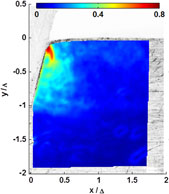Article contents
Modes of deformation and weak boundary conditions in wedge indentation
Published online by Cambridge University Press: 25 April 2012
Abstract

We study strain fields and deformation patterns produced by wedge indentation of metals using high-resolution imaging, image correlation and simulation. A long-standing problem associated with simulation of narrow angle wedge indentation is overcome by introducing a weak form of the symmetry boundary conditions. The simulated deformation fields show good agreement with experiment. Based on strain localization, three distinct modes of deformation largely cover the range of wedge angles. Importantly, narrow angle wedge indentation is characterized by intense strain localization at points close to the free surface and thus offers a possible new tool to probe strain gradient effects.
- Type
- Research Letters
- Information
- Copyright
- Copyright © Materials Research Society 2012
References
- 9
- Cited by




